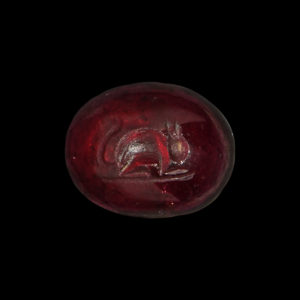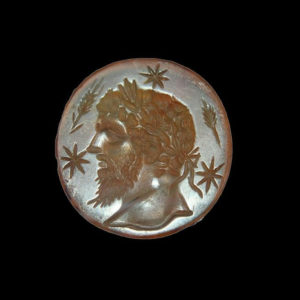A Roman garnet intaglio with one side incised with the left profile head of Zeus Serapis wearing a modius crown, surrounded by Greek letters I,Λ,φ, ν, Λ,Λ,Ϲ,Ϲ,Ε,Δ
The other side with enigmatic inscription ‘BIKIω PIΗΔνMΗ IΔ φI ΛA’.
Serapis, also spelt Sarapis, Greco-Egyptian deity of the Sun first encountered at Memphis, where his cult was celebrated in association with that of the sacred Egyptian bull Apis (who was called Osorapis when deceased). He was thus originally a god of the underworld but was reintroduced as a new deity with many Hellenic aspects by Ptolemy I Soter (reigned 305–284 BCE), who centred the worship of the deity at Alexandria.
The Serapeum at Alexandria was the largest and best known of the god’s temples. The cult statue there represented Serapis as a robed and bearded figure regally enthroned, his right hand resting on Cerberus (the three-headed dog who guards the gate of the underworld), while his left held an upraised sceptre. Gradually Serapis became revered not only as a Sun god (“Zeus Serapis”) but also as a lord of healing and of fertility. His worship was established in Rome and throughout the Mediterranean, following the trade routes and being particularly prominent in the great commercial cities.
Among the Gnostics (early Christian heretics who believed that matter is evil and the spirit is good) he was a symbol of the universal godhead.
CONDITION: In a good condition. Few chips. The item is described to the best of our knowledge. Please refer to the pictures and email with any questions.






